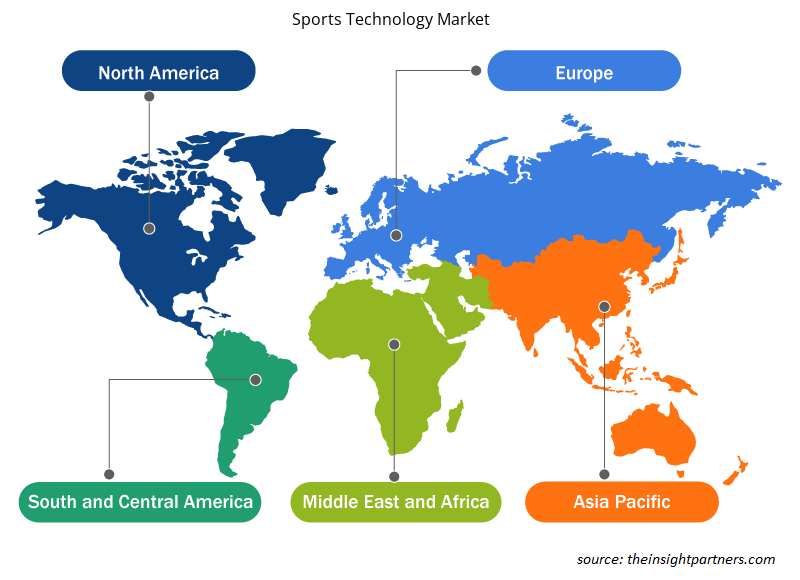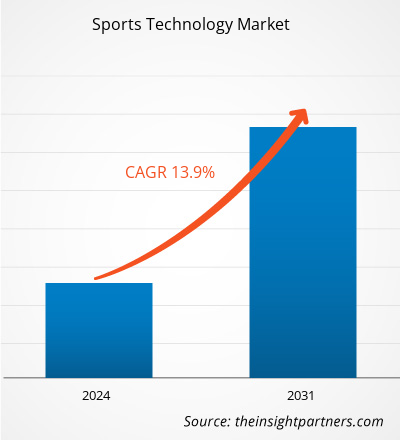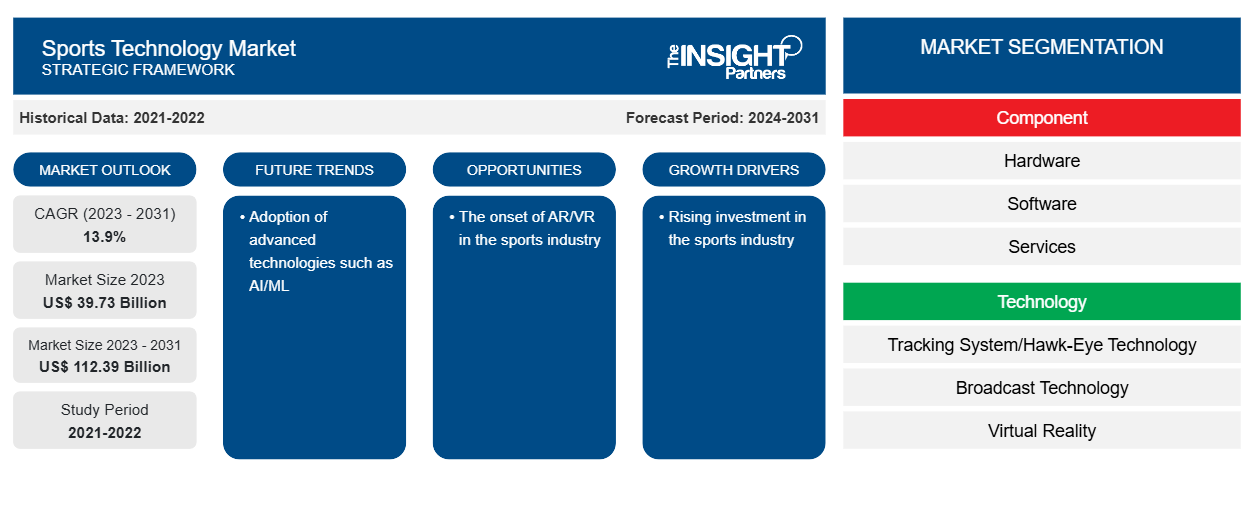Se prevé que el tamaño del mercado de tecnología deportiva alcance los 112.390 millones de dólares en 2031, frente a los 39.730 millones de dólares en 2023. Se espera que el mercado registre una CAGR del 13,9 % entre 2023 y 2031. Es probable que la inversión en las industrias deportivas y la inclinación hacia la toma de decisiones basada en datos sigan siendo tendencias clave en el mercado de la tecnología deportiva.
Análisis del mercado de la tecnología deportiva
El crecimiento del mercado de tecnología deportiva en la demanda de servicios basados en tecnología en la industria del deporte se puede atribuir a la transformación digital de los estadios y arenas, junto con el mayor enfoque en la participación de la audiencia y las actividades de entretenimiento. Se prevé que el mercado crezca significativamente durante el período de pronóstico debido al aumento de la demanda de toma de decisiones y operaciones basadas en datos, así como al número de eventos deportivos. Se anticipa que el mercado de tecnología deportiva continuará expandiéndose debido al creciente uso de las redes sociales, Internet de las cosas (IoT) y análisis de datos.
Panorama del mercado de la tecnología deportiva
Las tecnologías deportivas son métodos creados por el hombre para alcanzar los intereses o metas humanas relacionadas con un deporte en particular. La tecnología en el deporte se refiere a los medios técnicos mediante los cuales los atletas intentan mejorar su entrenamiento y su entorno competitivo para mejorar su rendimiento atlético general.
Personalice este informe según sus necesidades
Obtendrá personalización en cualquier informe, sin cargo, incluidas partes de este informe o análisis a nivel de país, paquete de datos de Excel, así como también grandes ofertas y descuentos para empresas emergentes y universidades.
-
Obtenga las principales tendencias clave del mercado de este informe.Esta muestra GRATUITA incluirá análisis de datos, desde tendencias del mercado hasta estimaciones y pronósticos.
Factores impulsores y oportunidades del mercado de la tecnología deportiva
Creciente inversión en la industria del deporte favorece al mercado
El mercado de la tecnología deportiva ha crecido en los últimos años a medida que más organizaciones invierten en la adopción de tecnologías de vanguardia para el seguimiento del rendimiento de los jugadores y la participación de los aficionados. Además, el gobierno apoya a la industria deportiva con inversiones y actividades de asociación, lo que conduce a la adopción de tecnologías en los deportes. A continuación se mencionan algunos de los casos:
- En febrero de 2024, la Administración Biden-Harris anunció una nueva asociación con las principales ligas deportivas y asociaciones de jugadores para impulsar la actividad física y aumentar la programación nutricional en todo el país.
- En la India, en el marco del Programa Nacional de Inversiones, se han destinado gastos de capital de 1.100 millones de dólares (años fiscales 2020-25) para desarrollar infraestructura deportiva en el país.
Adopción de tecnologías avanzadas como IA/ML: una oportunidad en el mercado de la tecnología deportiva
La creciente adopción de la tecnología de inteligencia artificial (IA)/ aprendizaje automático (AA) ha creado oportunidades significativas en el mercado de la tecnología deportiva. Las tecnologías de IA/AA se utilizan para analizar los datos de rendimiento de los jugadores con el fin de ayudar a los entrenadores a identificar áreas de mejora. Por ejemplo, las cámaras impulsadas por IA pueden rastrear y analizar los movimientos, la precisión, la velocidad y otras métricas de rendimiento de los jugadores. Esta información se puede utilizar para desarrollar planes de entrenamiento personalizados para los jugadores que buscan mejorar sus habilidades. Por lo tanto, los líderes de la industria se centran en llevar la tecnología de IA a la industria del deporte, lo que impulsará el mercado de la tecnología deportiva en los próximos años. En abril de 2024, el Comité Olímpico Internacional (COI) lanzó la Agenda Olímpica de IA, que establece el impacto previsto que la Inteligencia Artificial (IA) puede ofrecer a los deportes y cómo el COI pretende liderar la implementación global de la IA en los deportes.
Análisis de segmentación del informe del mercado de tecnología deportiva
Los segmentos clave que contribuyeron a la derivación del análisis del mercado de tecnología deportiva son los componentes y la tecnología.
- Según los componentes, el mercado se segmenta en hardware, software y servicios. El segmento de hardware tuvo una mayor participación de mercado en 2023.
- Por tecnología, el mercado se segmenta en sistemas de seguimiento/tecnología de ojo de halcón, tecnología de transmisión , realidad virtual, tecnología portátil y otras tecnologías. El segmento de tecnología de transmisión tuvo una mayor participación de mercado en 2023.
Análisis de la cuota de mercado de la tecnología deportiva por geografía
El alcance geográfico del informe del mercado de tecnología deportiva se divide principalmente en cinco regiones: América del Norte, Asia Pacífico, Europa, Medio Oriente y África, y América del Sur/América del Sur y Central.
En términos de ingresos, América del Norte representó la mayor participación en el mercado de tecnología deportiva en 2023. América del Norte es una de las primeras en adoptar soluciones tecnológicas, lo que lleva a que su participación de mercado se dispare. Se espera que Asia Pacífico crezca con la CAGR más alta. El crecimiento del mercado en APAC se atribuye a la presencia de un mayor número de actores del mercado de tecnología deportiva.
Perspectivas regionales del mercado de tecnología deportiva
Los analistas de Insight Partners explicaron en detalle las tendencias y los factores regionales que influyen en el mercado de tecnología deportiva durante el período de pronóstico. Esta sección también analiza los segmentos y la geografía del mercado de tecnología deportiva en América del Norte, Europa, Asia Pacífico, Oriente Medio y África, y América del Sur y Central.

- Obtenga datos regionales específicos para el mercado de tecnología deportiva
Alcance del informe sobre el mercado de tecnología deportiva
| Atributo del informe | Detalles |
|---|---|
| Tamaño del mercado en 2023 | US$ 39,73 mil millones |
| Tamaño del mercado en 2031 | US$ 112,39 mil millones |
| CAGR global (2023 - 2031) | 13,9% |
| Datos históricos | 2021-2022 |
| Período de pronóstico | 2024-2031 |
| Segmentos cubiertos |
Por componente
|
| Regiones y países cubiertos |
América del norte
|
| Líderes del mercado y perfiles de empresas clave |
|
Densidad de actores del mercado de tecnología deportiva: comprensión de su impacto en la dinámica empresarial
El mercado de tecnología deportiva está creciendo rápidamente, impulsado por la creciente demanda de los usuarios finales debido a factores como la evolución de las preferencias de los consumidores, los avances tecnológicos y una mayor conciencia de los beneficios del producto. A medida que aumenta la demanda, las empresas amplían sus ofertas, innovan para satisfacer las necesidades de los consumidores y aprovechan las tendencias emergentes, lo que impulsa aún más el crecimiento del mercado.
La densidad de actores del mercado se refiere a la distribución de las empresas o firmas que operan dentro de un mercado o industria en particular. Indica cuántos competidores (actores del mercado) están presentes en un espacio de mercado determinado en relación con su tamaño o valor total de mercado.
Las principales empresas que operan en el mercado de tecnología deportiva son:
- Catapulta
- ESTADÍSTICAS DEPORTIVAS
- Fitbit
- Samsung
- Xiaomi
- Oráculo
Descargo de responsabilidad : Las empresas enumeradas anteriormente no están clasificadas en ningún orden particular.

- Obtenga una descripción general de los principales actores clave del mercado de tecnología deportiva
Noticias y desarrollos recientes del mercado de tecnología deportiva
El mercado de la tecnología deportiva se evalúa mediante la recopilación de datos cualitativos y cuantitativos a partir de una investigación primaria y secundaria, que incluye publicaciones corporativas importantes, datos de asociaciones y bases de datos. A continuación, se incluye una lista de los avances del mercado:
- En noviembre de 2023, Tech Mahindra, un proveedor líder de soluciones y servicios de transformación digital, consultoría y reingeniería empresarial, anunció que había colaborado con Amazon Web Services (AWS) para construir una plataforma de nube deportiva. La oferta se centra en la creación de capacidades digitales de última generación para organizaciones deportivas y en la entrega de experiencias inmersivas y personalizadas a los entusiastas del deporte en todo el mundo. La oferta de nube deportiva es el resultado de un Acuerdo de Colaboración Estratégica (SCA) firmado entre las dos organizaciones en septiembre de 2023, con una visión compartida de acercar las instituciones deportivas a los fanáticos y a los fanáticos a la acción. El SCA facilita el acceso de Tech Mahindra a los recursos y servicios de AWS y permite que ambas entidades participen en iniciativas conjuntas de comercialización e impulsen el crecimiento empresarial. (Fuente: Tech Mahindra, comunicado de prensa, 2023)
- En marzo de 2024, Atos anunció el plan de abrir un Centro de Excelencia en Tecnología Deportiva pionero dentro de la nueva sede de Atos en Oriente Medio y Norte de África en el segundo trimestre de 2024 en Riad, Arabia Saudita. Anunciado en LEAP 2024, el Centro de Excelencia aprovechará la trayectoria global de Atos en la prestación de los mejores servicios y soluciones de TI para eventos deportivos globales. El Centro desarrollará aplicaciones tecnológicas de vanguardia para beneficiar a los atletas, los fanáticos y el movimiento deportivo en Arabia Saudita. (Fuente: Atos, comunicado de prensa, 2024)
Cobertura y resultados del informe sobre el mercado de tecnología deportiva
El informe “Tamaño y pronóstico del mercado de tecnología deportiva (2021-2031)” proporciona un análisis detallado del mercado que cubre las siguientes áreas:
- Tamaño del mercado y pronóstico a nivel global, regional y nacional para todos los segmentos clave del mercado cubiertos bajo el alcance
- Dinámica del mercado, como impulsores, restricciones y oportunidades clave
- Principales tendencias futuras
- Análisis detallado de las cinco fuerzas de Porter y PEST y FODA
- Análisis del mercado global y regional que cubre las tendencias clave del mercado, los principales actores, las regulaciones y los desarrollos recientes del mercado.
- Análisis del panorama de la industria y de la competencia que abarca la concentración del mercado, el análisis de mapas de calor, los actores destacados y los desarrollos recientes
- Perfiles detallados de empresas
- Análisis histórico (2 años), año base, pronóstico (7 años) con CAGR
- Análisis PEST y FODA
- Tamaño del mercado, valor/volumen: global, regional y nacional
- Industria y panorama competitivo
- Conjunto de datos de Excel
Informes recientes
Testimonios
Razón para comprar
- Toma de decisiones informada
- Comprensión de la dinámica del mercado
- Análisis competitivo
- Información sobre clientes
- Pronósticos del mercado
- Mitigación de riesgos
- Planificación estratégica
- Justificación de la inversión
- Identificación de mercados emergentes
- Mejora de las estrategias de marketing
- Impulso de la eficiencia operativa
- Alineación con las tendencias regulatorias























 Obtenga una muestra gratuita para - Mercado de tecnología deportiva
Obtenga una muestra gratuita para - Mercado de tecnología deportiva